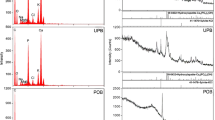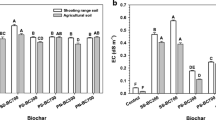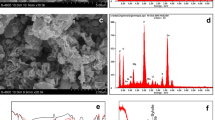Abstract
Biochar is a potential amendment for improving soil fertility due to its richness of nutrients, P, K, Ca, and Mg. However, soil amended with metal-rich biochars may pose a risk of heavy metal release to the environment. Biochars derived from pig manure and sewage sludge (PM-biochar and SS-biochar) were investigated for their nutrient and heavy metal release in two soils (acidic and alkaline soil) under simulated landfill and acid rain conditions. Results showed that under both environmental conditions, adding PM-biochar into the soil increased K, P, and Mg release significantly by about 40–50 times, while only 2–4 times increase of the nutrients was observed in the SS-biochar-amended soil. The Ca release was higher in the SS-biochar-amended soil than in the PM-biochar-amended soil. Higher P, Ca, and Mg nutrient release was observed in alkaline soil than in acidic soil under the two environmental conditions though K release was not significant in both soils. A kinetic study in solution illustrated that the release of nutrients from biochar was initially via desorption and diffusion under environmental conditions and then through slow dissolution of insoluble species. More release of nutrients and heavy metals was observed in the biochar-amended soil under the landfill condition than under the acid rain condition. Although this release was limited under the acid rain condition, leaching of Fe and Mn exceeded the limitations of the groundwater standard value of China. Overall, biochar could be utilized as a prospective soil fertilizer by supplying nutrients such as P, K, Ca, and Mg, while the release of Fe and Mn should be paid more attention due to the risk of these metals impacting groundwater.





Similar content being viewed by others
References
American Society for Testing and Materials (ASTM) (2000) Annual book of ASTM standards, soil and rock, vol. 4.08
Bakshi S, He ZL, Harris WG (2014) Biochar amendment affects leaching potential of copper and nutrient release behavior in contaminated sandy soils. J Environ Qual 43:1894–1902
Beesley L, Moreno-Jiménez E, Gomez-Eyles JL (2010) Effects of biochar and green waste compost amendments on mobility, bioavailability and toxicity of inorganic and organic contaminants in a multi-element polluted soil. Environ Pollut 158:2282–2287
Beesley L, Moreno-Jiménez E, Gomez-Eyles JL, Harris E, Robinson B, Sizmur T (2011) A review of biochars’ potential role in the remediation, revegetation and restoration of contaminated soils. Environ Pollut 159:3269–3282
Buss W, Graham MC, Shepherd JG, Mašek O (2016) Suitability of marginal biomass-derived biochars for soil amendment. Sci Total Environ 547:314–322
Cantrell KB, Hunt PG, Uchimiya M, Novak JM, Ro KS (2012) Impact of pyrolysis temperature and manure source on physicochemical characteristics of biochar. Bioresour Technol 107:419–428
Cao XD, Dermatas D (2008) Evaluating the applicability of regulatory leaching tests for assessing lead leachability in contaminated shooting range soils. Environ Monit Assess 139:1–13
Cao XD, Harris W (2010) Properties of dairy-manure-derived biochar pertinent to its potential use in remediation. Bioresour Technol 101:5222–5228
Cao XD, Ma L, Gao B, Harris W (2009) Dairy-manure derived biochar effectively sorbs lead and atrazine. Environ Sci Technol 43:3285–3291
Chan KY, Van ZL, Meszaros I, Downie A, Joseph S (2008) Using poultry litter biochars as soil amendments. Soil Res 46:437–444
China Ministry of Environmental Protection (CMEP) (1993) Quality standard for ground water (GB/T14848–93). China Environmental Science Press, Beijing
Dünisch O, Lima VC, Seehann G, Donath J, Montóia VR, Schwarz T (2007) Retention properties of wood residues and their potential for soil amelioration. Wood Sci Technol 41:169–189
Halim CE, Scott JA, Natawardaya H, Amal R, Beydoun D, Low G (2004) Comparison between acetic acid and landfill leachates for the leaching of Pb(II), Cd(II), As(V), and Cr(VI) from cementitious wastes. Environ Sci Technol 38:3977–3983
Hamdi W, Pelster D, Seffen M (2013) Phosphorus sorption kinetics in different types of alkaline soils. Arch Agron Soil Sci 60:577–586
Hass A, Gonzalez JM, Lima IM, Godwin HW, Halvorson JJ, Boyer DG (2012) Chicken manure biochar as liming and nutrient source for acid Appalachian soil. J Environ Qual 41:1096–1106
Jin HM, Arazo RO, Gao J, Capareda S, Chang ZZ (2014) Leaching of heavy metals from fast pyrolysis residues produced from different particle sizes of sewage sludge. J Anal Appl Pyrol 109:168–175
Kim P, Hensley D, Labbé N (2014) Nutrient release from switchgrass-derived biochar pellets embedded with fertilizers. Geoderma 232-234:341–351
Laird D, Fleming P, Wang B, Horton R, Karlen D (2010) Biochar impact on nutrient leaching from a midwestern agricultural soil. Geoderma 158:436–442
Lee JW, Kidder M, Evans BR, Paik S, Buchanan AC, Garten CT, Brown RC (2010) Characterization of biochars produced from cornstovers for soil amendment. Environ Sci Technol 44:7970–7974
Lehmann J, Joseph S (2009) Biochar for environmental management. Science and Technology Earthscan, Ltd., London
Lehmann A, Rillig MC, Thies J, Masiello CA, Hockaday WC, Crowley D (2011) Biochar effects on soil biota—a review. Soil Biol Biochem 43:1812–1836
Liang Y, Cao X, Zhao L, Xu X, Harris W (2014) Phosphorus release from dairy manure, the manure-derived biochar, and their amended soil: effects of phosphorus nature and soil property. J Environ Qual 43:1504–1509
Liesch AM, Weyers SL, Gaskin JW, Das KC (2010) Impact of two different biochars on earthworm growth and survival. Ann Environ Sci 4:1–9
Lone AH, Najar GR, Ganie MA, Sofi JA, Ali T (2015) Biochar for sustainable soil health: a review of prospects and concerns. Pedosphere 25:639–653
Major J, Rondon M, Molina D, Riha SJ, Lehmann J (2012) Nutrient leaching in a colombian savanna oxisol amended with biochar. J Environ Qual 41:1076–1086
Mcdowell R, Sharpley A, Brookes P, Poulton P (2001) Relationship between soil test phosphorus and phosphorus release to solution. Soil Sci 166:137–149
Netzer A, Wilkinson P, Beszedits S (1974) Removal of trace metals from wastewater by treatment with lime and discarded automotive tires. Water Res 10:813–817
Parvage MM, Ulén B, Kirchmann H (2013) A survey of soil phosphorus (P) and nitrogen (N) in Swedish horse paddocks. Agric Ecosyst Environ 178:1–9
Qin F, Shan XQ, Wei B (2004) Effects of low-molecular-weight organic acids and residence time on desorption of Cu, Cd, and Pb from soils. Chemosphere 57:253–263
Shen X, Huang DY, Ren XF, Zhu HH, Wang S, Xu C, He YB, Luo ZC, Zhu QH (2016) Phytoavailability of Cd and Pb in crop straw biochar-amended soil is related to the heavy metal content of both biochar and soil. J Environ Manag 168:245–251
Silber A, Levkovitch I, Graber ER (2010) pH-dependent mineral release and surface properties of cornstraw biochar: agronomic implications. Environ Sci Technol 44:9318–9323
USEPA (1986) Test methods for evaluating solid waste, laboratory manual physical/chemical methods, vol 1A, 3rd edn. SW-846, U.S. Government Printing Office, US Environmental Pollution Agency, Washington, DC
USEPA (1992) Method 1311: test methods for evaluating solid waste, physical/chemical methods, SW-846 3rd edn. US Environmental Pollution Agency, Washington, DC
USEPA (1994) Method 1312: test methods for evaluating solid waste, physical/chemical methods, SW-846 3rd edn. US Environmental Pollution Agency, Washington, DC
Wang YJ, Chen JH, Cui YX, Wang SQ, Zhou DM (2009) Effects of low-molecular-weight organic acids on Cu(II) adsorption onto hydroxyapatite nanoparticles. J Hazard Mater 162:1135–1140
Wesenbeeck SV, Prins W, Ronsse F, Antal MJ Jr (2014) Sewage sludge carbonization for biochar applications. Fate of heavy metals. Energy Fuel 28:5318–5326
Wu H, Che X, Ding Z, Hu X, Creamer AE, Chen H, Gao B (2016) Release of soluble elements from biochars derived from various biomass feedstocks. Environ Sci Pollut Res 23:1905–1915
Xu XY, Cao XD, Zhao L (2013) Comparison of rice husk- and dairy manure-derived biochars for simultaneously removing heavy metals from aqueous solutions: role of mineral components in biochars. Chemosphere 92:955–961
Xu G, Sun JN, Shao HB, Chang SX (2014) Biochar had effects on phosphorus sorption and desorption in three soils with differing acidity. Ecol Eng 62:54–60
Yao Y, Gao B, Zhang M, Inyang M, Zimmerman AR (2012) Effect of biochar amendment on sorption and leaching of nitrate, ammonium, and phosphate in a sandy soil. Chemosphere 89:1467–1471
Yuan JH, RK X, Zhang H (2011) The forms of alkalis in the biochar produced from crop residues at different temperatures. Bioresour Technol 102:3488–3497
Yuan H, Lu T, Wang Y, Chen Y, Lei T (2016) Sewage sludge biochar: nutrient composition and its effect on the leaching of soil nutrients. Geoderma 267:17–23
Zhao L, Cao X, Wang Q, Yang F, Xu S (2013) Mineral constituents profile of biochar derived from diversified waste biomasses: implications for agricultural applications. J Environ Qual 42:545–552
Zhao L, Zheng W, Cao XD (2014) Distribution and evolution of organic matter phases during biochar formation and their importance in carbon loss and pore structure. Chem Eng J 250:240–247
Zhao L, Cao X, Zheng W, Scott JW, Sharma BK, Chen X (2016) Copyrolysis of biomass with phosphate fertilizers to improve biochar carbon retention, slow nutrient release, and stabilize heavy metals in soil. ACS Sustain Chem Eng 21:409–414
Zheng H, Wang Z, Deng X, Zhao J, Luo Y, Novak J, Herbert S, Xing BS (2013) Characteristics and nutrient values of biochars produced from giant reed at different temperatures. Bioresour Technol 130:463–471
Funding
This study was supported by the National Natural Science Foundation of China (Nos. 21537002, 21577087, 21607002), Scientific and Technological Projects of Anhui Province (No. 1704e1002238), and Anhui Laimujia Biotechnology Co. Ltd.
Author information
Authors and Affiliations
Corresponding author
Additional information
Responsible editor: Zhihong Xu
Rights and permissions
About this article
Cite this article
Zhao, Y., Zhao, L., Mei, Y. et al. Release of nutrients and heavy metals from biochar-amended soil under environmentally relevant conditions. Environ Sci Pollut Res 25, 2517–2527 (2018). https://doi.org/10.1007/s11356-017-0668-9
Received:
Accepted:
Published:
Issue Date:
DOI: https://doi.org/10.1007/s11356-017-0668-9




